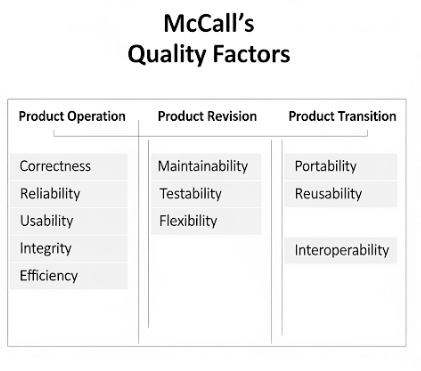- Metrics for Process and Products
- Software measurement
- Metrics for Software Quality
- Risk Management
- Reactive versus Proactive Risk Strategies
- Software Risks
- Risk Identification
- Risk Projection
- Risk Refinement
- RMMM
- RMMM Plan
- Quality Management
- Quality Concepts
- Software Reviews
- Formal Technical Reviews
- Statistical Software Quality Assurance
- Software Reliability
- The ISO 9000 Quality Standards
Metrics for Process and Products
In software engineering, metrics for process and products are crucial quantitative measures applied to evaluate both the software development process and the characteristics of the software product itself. These metrics provide objective data that helps organizations understand, control, and improve their development practices and the quality of their deliverables. By systematically collecting and analyzing these measures, teams can identify bottlenecks, assess efficiency, make informed decisions, and ultimately enhance the overall effectiveness of software creation. This allows for continuous improvement and better outcomes.
Software Measurement
Software measurement is the foundation of all metrics in software engineering. It involves deriving a quantitative value from an attribute of a software process or product. Essentially, it’s the act of assigning numbers or symbols to software attributes to characterize them. This systematic approach allows for objective assessment rather than relying solely on subjective opinions.
Reasons for Software Measurement:
- To Understand: To gain deeper insights into the process and product.
- To Control: To manage and guide the development process more effectively.
- To Plan: To make more accurate predictions and resource allocations for future projects.
- To Improve: To identify areas where the process or product can be enhanced.
Principles of Measurement:
The process of software measurement typically follows a set of principles to ensure its effectiveness:
- Formulation: Defining the specific attributes of the process or product to be measured.
- Collection: Gathering the necessary data accurately and consistently.
- Analysis: Interpreting the collected data to extract meaningful information.
- Interpretation: Drawing conclusions from the analyzed data in the context of the project.
- Feedback: Using the insights gained to make adjustments and improvements to the process or product.
These principles ensure that measurement is a systematic and useful activity, providing actionable insights for software teams.
Metrics for Software Quality
Metrics for software quality specifically focus on quantifying the attributes that contribute to the overall excellence of a software product. These quality factors were introduced in Unit 4, but here the focus is on how to measure them. These metrics help ensure that the software meets its requirements, satisfies user needs, and performs reliably.
Key Quality Factors and Their Measurement:
McCalls’s Quality Factors
McCall’s Quality Factors provide a useful framework for understanding software quality attributes and how they can be measured. They categorize quality into three main perspectives:
- Product Operation: Focuses on correctness, reliability, efficiency, integrity, and usability (e.g., how easy it is to use the software).
- Product Revision: Addresses maintainability, flexibility, and testability (e.g., how easy it is to fix or change the software).
- Product Transition: Deals with portability, reusability, and interoperability (e.g., how easy it is to adapt to new environments or integrate with other systems).
Each of these factors can be broken down into specific metrics that help quantify the attribute.
A Framework for Product Metrics
A comprehensive framework for product metrics often includes:
- Measures, Metrics, and Indicators: Understanding the distinction between these terms is crucial. A measure is a quantitative indication of the extent, amount, dimension, or size of some attribute. A metric is a quantitative measure of the degree to which a system, component, or process possesses a given attribute. An indicator is a metric or combination of metrics that provides insight into the software process, software project, or the product itself.
- The Challenge of Product Metrics: Despite their benefits, implementing product metrics can be challenging. This involves selecting the right metrics, ensuring data collection accuracy, and interpreting results effectively without leading to misinterpretations or misuse.
- Measurement Principles: Adhering to principles like formulation, collection, analysis, interpretation, and feedback is essential for effective measurement.
- Goal-Oriented Software Measurement: Metrics should always be aligned with specific project or organizational goals. This ensures that the data collected is relevant and actionable.
- Attributes of Effective Metrics: Effective metrics are simple, objective, easy to collect, provide timely feedback, and are sensitive to changes in the process or product.
Function Point (FP) Model
The Function Point (FP) model, as discussed in Unit 4, is a prime example of a product metric that focuses on software quality from a functionality perspective. It quantifies the functionality delivered to the user, making it a valuable metric for assessing product size and complexity, which indirectly impacts quality attributes like maintainability and testability.
Metrics for Analysis Model and Design Model
While covered in Unit 4, it’s important to reiterate that metrics from the analysis and design models (such as those for specification quality, object-oriented design, architectural design, structural complexity, data complexity, coupling, cohesion, and completeness) are also integral to understanding and ensuring software quality. They provide early indicators of potential quality issues.
Conclusion
Metrics for process and products are indispensable tools in modern software engineering. By employing systematic software measurement and focusing on various metrics for software quality—guided by frameworks like McCall’s Quality Factors and utilizing principles of effective measurement—organizations can gain deep insights into their development efforts. This quantitative approach allows teams to continuously monitor, control, and improve their processes and ultimately deliver higher-quality software products that meet both explicit requirements and implicit user expectations.
